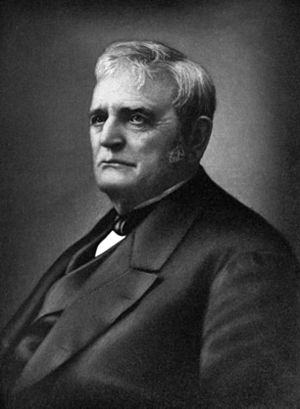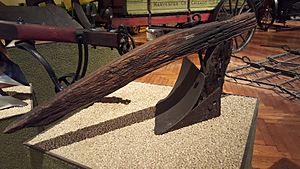John Deere (inventor) facts for kids
Quick facts for kids
John Deere
|
|
|---|---|
 |
|
| Born | February 7, 1804 Rutland, Vermont, United States
|
| Died | May 17, 1886 (aged 82) Moline, Illinois, United States
|
| Education | Middlebury College |
| Occupation | Blacksmith, businessman, inventor, politician |
| Known for | Deere & Company, steel plow |
| Spouse(s) | Demarius Lamb (1827–1886) |
| Children | 9 |
| Signature | |
John Deere (born February 7, 1804 – died May 17, 1886) was an American blacksmith, businessman, and inventor. He also served as a politician. John Deere founded Deere & Company. This company is now one of the biggest makers of farm and construction machines in the world. He was born in Rutland, Vermont. Later, he moved to Illinois and invented the first successful steel plow in 1837.
Contents
Early Life of John Deere
John Deere was born on February 7, 1804, in Rutland, Vermont. His father, William Rinold Deere, was a tailor. His mother was Sarah Yeats. John went to Middlebury College for a short time.
At age 17, in 1821, he started learning to be a blacksmith. He trained with Captain Benjamin Lawrence, a skilled blacksmith. In 1826, John Deere started his own blacksmith business. He married Demarius Lamb in 1827. Together, they had nine children.
Deere worked in different towns in Vermont. These included Burlington, Vergennes, and Leicester. In 1836, times were tough in Vermont. So, Deere moved to Illinois. He followed a business friend named Leonard Andrus.
The Steel Plow Invention
John Deere settled in Grand Detour, Illinois. It was easy for him to find work there. Not many blacksmiths were in the area. Deere noticed that the plows farmers used were not working well. These plows were made of cast iron. They struggled with the tough, sticky soil of the Illinois prairie.
Deere remembered how needles were polished in his father's tailor shop. They became smooth by running them through sand. He thought a plow made of very smooth, polished steel would work better. It would clean itself as it moved through the soil. This idea led to his famous self-scouring steel plow.
There are different stories about how he got the idea. One story says he thought about how polished steel pitchforks moved through hay and soil. Another story says he used an old saw blade that was already polished from years of use.
In 1837, Deere created and built the first successful cast-steel plow. This plow had a strong wrought-iron frame. It also had a shiny, polished steel part that cut the soil. This design was perfect for the difficult soil in the Midwest. It worked much better than other plows.
By early 1838, Deere finished his first steel plow. He sold it to a local farmer, Lewis Crandall. The farmer quickly told everyone how well Deere's plow worked. Soon, two neighbors ordered plows from Deere. By 1841, Deere was making 75 to 100 plows each year.
In 1843, Deere teamed up with Leonard Andrus. They wanted to make more plows to meet the high demand. However, they had different ideas. Deere wanted to sell plows to people outside Grand Detour. Andrus did not want a railroad built through Grand Detour. Deere also did not trust Andrus's way of keeping money records.
In 1848, Deere ended his partnership with Andrus. He moved his business to Moline, Illinois. Moline was a great place for shipping goods. It was located on the Mississippi River. By 1855, Deere's factory sold over 10,000 plows. His plow became known as "The Plow that Broke the Plains." A historical marker in Vermont remembers this important invention.
Deere always wanted to make high-quality machines. He once said, "I will never put my name on a product that does not have in it the best that is in me." After a tough economic time in 1857, business got better. Deere then let his son, Charles, manage the daily work. In 1868, Deere officially made his business a company called Deere & Company.
Later Life and Legacy
Later in his life, John Deere spent most of his time on public and political matters. He was the president of the National Bank of Moline. He also served as a director for the Moline Free Public Library. He was a trustee for the First Congregational Church.
Deere also served as the mayor of Moline for two years. However, he had chest pains and an illness. Because of this, he decided not to run for mayor again. In 1875, he bought and improved a house. This house is now known as John Deere House. He passed away at his home, called Red Cliff, on May 17, 1886. He was 82 years old.
Images for kids
-
The John Deere House in Grand Detour, Illinois, built 1836
-
A monument in Middlebury, Vermont marking the shop where John Deere learned to be a blacksmith
See also
 In Spanish: John Deere para niños
In Spanish: John Deere para niños





